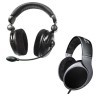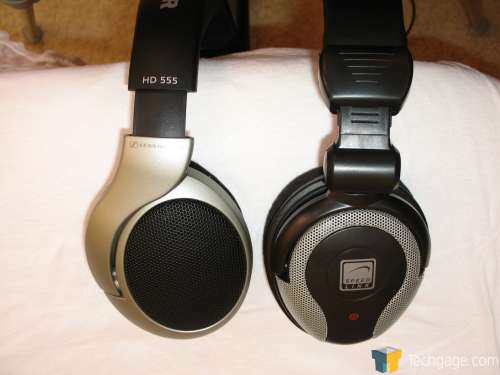- Qualcomm Launches Snapdragon 4 Gen 2 Mobile Platform
- AMD Launches Ryzen PRO 7000 Series Mobile & Desktop Platform
- Intel Launches Sleek Single-Slot Arc Pro A60 Workstation Graphics Card
- NVIDIA Announces Latest Ada Lovelace Additions: GeForce RTX 4060 Ti & RTX 4060
- Maxon Redshift With AMD Radeon GPU Rendering Support Now Available
Speedlink Medusa 5.1 and Sennheiser HD555

The choice between stereo and 5.1 headphones can be complicated, so we are taking a look at a popular sub-$150 offering of each type to see which one will come out on top. As we find out, the choice can make quite a big difference depending on what you will use your PC for most.
Page 3 – Sennheiser HD555, Build Quality
The Sennheiser HD555s retail for anywhere from ~$110 to $150 depending on where you shop, and seem to be the sweet-spot of the Sennheiser HD line price-wise. The lower-end HD515s can’t be found for much under $80, the higher-end HD595s go for $200. The HD555’s features can be seen on Sennheiser’s website.
The first thing you may notice comparing the features of the two headsets is that Sennheiser seems to employ engineers to do their marketing.
The Ergonomic Acoustic Refinement (E.A.R.) feature is basically the overall shape of the headset, which is incredibly comfortable, and I’ll talk about it more in a bit. The Duofol diaphragm entry has yet to be written in Wikipedia, but eliminating standing waves will reduce distortion, so the sound should be very well defined.
The neodymium ferrous magnet system is a fancy way of saying that their speakers are really good – magnetic forces are what cause a speaker to vibrate, creating sound waves – the main benefits of neodymium magnets is that they are much stronger than ceramic magnets by volume, so you can use smaller (lighter) magnets and still have more magnetic force to power the speakers. The others are self-explanatory, although the ‘spacious sound reproduction’ part is a little over-stated, as I will show in my testing.
I’m using these headphones simply because so many people are recommending them on various forums. I can say with high degree of certainty that all of the headphone threads I visited had at least one recommendation for these specific headphones, as well as Sennheiser in general and the HD series more specifically. Also, the next model up, the HD595s, cost a minimum of ~$200 so the HD555s make a decent price competitor with the Medusas.
Sennheiser’s packaging, while a little less extravagant, is nicely done. These are stereo headphones that do not require an amplifier, so this package includes only the HD555’s and a 3.5mm jack adapter.
The HD555s are also made from plastic, and appear to be very solid. One obvious difference here is that the HD555s don’t have any large hinges – the rotating joints are enclosed within the ear cups.
The soft fabric covering the cans is very similar to that of the Medusas, but the shape is very different. The HD555’s are more comfortable than the Medusas due to the shape of the ear cup. While the Medusas will contact both the area immediately around your ear as well as your actual earlobe, the HD555’s are designed so that nothing touches your earlobes at all.
There is noticeably more clamping force applied to your head, but there is plenty of padded surface area to distribute the pressure to the side of your head comfortably, and your ears are left untouched. The HD555s are easily the most comfortable set of headphones I’ve ever worn, and I believe that this ergonomic design actually improves the sounds that you hear because your earlobes aren’t being deformed by contact with the speaker cover.
The picture below shows the HD555s on the left, and you can see that the HD555 cups are deeper, meaning no contact with your ear.
The HD555s have a more minimalist approach for their frame. While this may make them marginally more robust, the real advantage here is comfort. There is a lot to be said for being able to perk up your ears while wearing headphones.
One other thing worth mentioning is that Sennheiser also offers a 2-year warranty on their headphones, and has a local service center in Connecticut where they perform repairs.
Now let’s see how both headsets sound.
|
|
Support our efforts! With ad revenue at an all-time low for written websites, we're relying more than ever on reader support to help us continue putting so much effort into this type of content. You can support us by becoming a Patron, or by using our Amazon shopping affiliate links listed through our articles. Thanks for your support!










